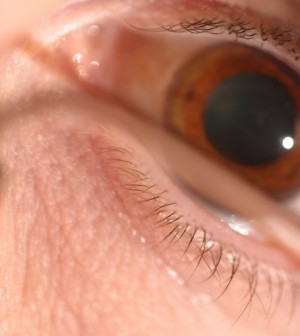- Skip Storing This Everyday Product in the Fridge Door
- Green Tea + B3 Pairing May Boost Brain Health
- Navigating Your Midlife Crisis: Embracing New Possibilities
- City Raccoons Showing Signs of Domestication
- Mapping the Exposome: Science Broadens Focus to Environmental Disease Triggers
- One Week Less on Social Media Linked to Better Mental Health
- Your Brain Changes in Stages as You Age, Study Finds
- Some Suicide Victims Show No Typical Warning Signs, Study Finds
- ByHeart Formula Faces Lawsuits After Babies Sickened With Botulism
- Switch to Vegan Diet Could Cut Your Greenhouse Gas Emissions in Half
FDA Approves 1st Drug for Diabetic Retinopathy


The U.S. Food and Drug Administration on Friday approved the drug Lucentis (ranibizumab) to treat diabetic retinopathy in patients with diabetic macular edema.
A leading cause of blindness among adults in the United States, diabetic retinopathy is the most common diabetic eye disease, the agency said in a news release.
In 2008, 33 percent of adults with diabetes aged 40 or older had some form of diabetic retinopathy. In some patients who have diabetic retinopathy with diabetic macular edema, abnormal new blood vessels grow on the surface of the retina and if the vessels burst severe vision loss or blindness can occur, the agency said.
“Diabetes is a serious public health crisis, affecting more patients every year,” Dr. Edward Cox, director of the Office of Antimicrobial Products in the FDA’s Center for Drug Evaluation and Research. “Today’s approval gives patients with diabetic retinopathy and diabetic macular edema the first significant therapy to treat this vision-impairing complication.”
Lucentis must be injected into the eye once a month by a doctor, and should be used alongside treatments to control blood sugar, blood pressure and cholesterol, according to the FDA.
The drug works by inhibiting leakage of blood vessels and deterring the growth of blood vessels into the retina of the eye, said Dr. Pravin Dugel, a retinal specialist at Retinal Consultants of Arizona and an investigator in the medication’s two clinical trials.
Diabetic retinopathy causes progressive damage to the retina, the light-sensitive lining at the back of the eye. The condition causes blood vessels to leak fluid into retinal tissue, and promotes the growth of abnormal new blood vessels on the surface of the retina.
About 7.7 million Americans with diabetes have suffered vision loss because of diabetic retinopathy, according to the U.S. National Institutes of Health. There currently are an estimated 29 million diabetics in the United States.
When given promptly, Lucentis can alter the progression of diabetic retinopathy and save vision, Dugel said.
“It truly is disease-modifying,” Dugel said. “In certain patients, if you treat up front, you can actually modify the disease in the eye.”
San Francisco-based Genentech developed Lucentis, which in 2012 received FDA approval for use in treating diabetic macular edema. In that condition, fluid builds up in the eye until the eye distorts and vision blurs.
Lucentis inhibits a signaling protein called VEGF that plays a critical role in the formation of new blood vessels and the leakiness of the vessels.
During the clinical trials that proved Lucentis’ effectiveness in treating diabetic macular edema, researchers found that the drug also helped people with diabetic retinopathy, Dugel said.
Those two trials followed 759 participants for three years, the FDA said. Patients treated with Lucentis showed significant improvement in the severity of their diabetic retinopathy at two years compared to patients who did not receive an injection.
The evidence was so strong that in October 2014 the FDA granted fast-track review to Lucentis for use in treating diabetic retinopathy.
One of the patients in the trials, Shirley Mortensen, said she received monthly injections for five years that successfully cleared up what she called “posts” — two black streaks near the left end corner of her vision.
“I could not see through them or around them or anything,” said Mortensen, 79, of San Jose, Calif. “Now they’re gone. They’re absolutely gone. It’s a fantastic drug, as far as I’m concerned.”
Up to now, the main treatment for diabetic retinopathy involved using lasers to essentially burn away tissue at the edges of the retinas, Dugel said. The procedure works, but it essentially destroys a person’s peripheral vision.
“That’s all we have,” he said. “It’s very effective treatment, but there’s a price to be paid. You’re also going to leave the eye with some missing areas of vision, because you are destroying retinal tissue.”
Most common side effects of Lucentis included bleeding in the tissue lining the inner part of the eyelids, eye pain, “floaters” and increased pressure within the eye.
The approval of a drug to treat diabetic retinopathy will be revolutionary in ongoing efforts to manage diabetes, Dugel said.
“In my world, it really has the potential to change the way we practice medicine,” he said. “It has the potential to benefit hundreds of thousands of patients.”
More information
The U.S. National Eye Institute has more on diabetic retinopathy.
Source: HealthDay
Copyright © 2025 HealthDay. All rights reserved.










